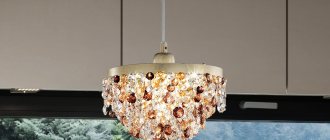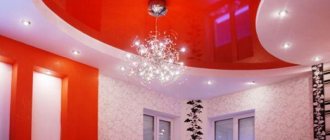For many years, choosing a chandelier for your home required only having an idea of the color and style that would suit a particular room. The fact is that previously chandeliers differed only in the design of the lampshade. With the advent of new types of light bulbs, buyers had to add technical parameters to their selection criteria: type of lamps, their number, level of energy consumption.
Nowadays the market offers a huge range of models with different characteristics, and a significant share of them are chandeliers operating from a remote control. In this article we will look at why they are good and what parameters you should pay attention to when purchasing such a model.
How to choose a chandelier that changes the color of light
LED lighting products have a wide color palette, making it so important to choose the right shade. It is recommended to keep the following guidelines in mind when purchasing:
- a soft yellow and transparent shade is an excellent option for lighting in residential areas; it is a tone that allows you to relax and does not tire the eyes;
- white promotes a better mood at work;
- red speeds up the heartbeat and raises blood pressure;
- green is an excellent option for creative or painstaking work;
- blue allows you to relax, this is a great option for a children's room;
- orange helps increase appetite, which is why it is most often used in the kitchen.
Thanks to the wide color spectrum, everyone can choose the right option for their home.
Important! In the evening, LED chandeliers with remote control can change the atmosphere of the room.
Models of ceiling chandeliers with remote control
You can find a wide range of LED products on sale. As a rule, each model has its own distinctive features depending on the shape, size, and color scheme. If we consider existing models according to the method of fastening, we can distinguish 2 options:
- ceiling;
- hanging.
Ceiling models are the most popular, as they can be used to highlight the interior design. In addition, this option is best suited for rooms with low ceilings.
Hanging lighting fixtures can add sophistication and elegance to a room. Such models are usually suitable for large rooms.
Accessories for ceiling lamps with remote control
Despite the fact that there is a wide range of LED chandeliers on sale, controlled from a remote control, they are all assembled from a control unit. The main components are a radio-controlled relay, a controller panel and an LED system. Depending on the chosen model, the kit may include a dimmer - it can be used to adjust the brightness of the lighting, or a halogen lamp. Since an LED lighting device with a control panel is an automated system, it cannot do without a controller that receives the signal coming from the remote control.
Main advantages
Having listed the features of chandeliers with a control panel, we can highlight their advantages over conventional ceiling lamps.
- The key advantage of such models is ease of use. You don't have to interrupt your work or other activities every time to go to the switch. Just take the remote control and press a couple of buttons.
By the way, the remote control can be stored in a special wall compartment next to the bed or desk - this arrangement will further increase the comfort of using the chandelier. Soon you'll get used to putting the remote control back in its place so you don't have to search all over the room for it.
- Possibility to adjust the light intensity depending on current needs. It's no secret that many children are afraid to fall asleep in the dark. Chandeliers with different modes will save you from the need to purchase a night light or garland - just turn on the desired mode, and the child will fall asleep under the soft light without fears or whims. The same applies to situations when you need to adjust the light intensity depending on the tasks being performed at the moment: while working or studying, you need brighter light, and for a romantic date, a more subdued option is suitable.
- Different colors of lighting. LED chandeliers can transform a room with just the click of a remote control. You probably know that color affects our perception of reality - there is even medical color therapy. By changing the shade of lighting, you can create the desired atmosphere in the room and improve your emotional state.
- Low power consumption. As you know, LEDs are quite economical, so you don’t have to worry that the new miracle of technology will increase your electricity bills.
Do not forget about the disadvantages that any household appliance has. LEDs often fail, and their cost is quite high. In addition, the price of chandeliers with such functionality is significantly higher than the price tags for conventional lamps. It turns out that both minuses are of a material nature, and the first one is random. Thus, such models have no significant disadvantages, and their small disadvantages are more than offset by beauty and functionality.
Pros - cons
LED lighting has many positive qualities. We can mention energy savings, the lifespan of diodes, and fire safety.
The main positive quality of models equipped with a remote control will be their ease of use. There is no need to run to the switch every time to turn the light on or off. Controlling the color of the lighting is also interesting, although this function is the least useful.
The ability to “dim” the lighting a little is also useful - in a children’s room you don’t have to turn off the lights completely, but simply “turn it down” as much as possible. This is a great solution for children who are afraid of the dark.
There are a lot of advantages, even with ordinary LED chandeliers, and more advanced models have simply a huge number of them. However, most people are primarily interested not in the positive aspects of such products, but in their inherent disadvantages.
LED lighting also has some negative qualities. You can’t do without them, and the main disadvantage of all such devices will be their considerable price. You always have to pay for convenience and comfort.
The diodes themselves are also not as ideal as their manufacturers claim. Unfortunately, such lamps fail quite often. Considering their considerable cost, this will be a significant disadvantage.
Even despite quite significant disadvantages, LED chandeliers have become a very interesting alternative to traditional solutions. They are not only functional, but also very beautiful. As for the high cost, it is gradually decreasing and will soon become equal to the cost of traditional chandeliers.
Of course, you can choose a simpler option, without such high-tech filling.
But why give up all the advantages that LED ceiling chandeliers with remote control provide? This is at least convenient, and often useful. For example, a patient who is not allowed to get up or is not recommended to move a lot can easily control the light without getting up.
"load...
Modern chandeliers with a remote control are lighting equipment that is distinguished not only by its stylish appearance, but also by its functionality and ease of use. Especially considering that the lamp will quickly respond to the wave of your hand. What's special about chandeliers with remote control and how to choose the model that suits you?
Features of choosing the optimal light source on the remote control
The quality of lamps with remote control is directly related to their price. Attempts to save money usually have negative consequences.
- When choosing, first of all pay attention to the technical characteristics.
- An option with inappropriate parameters risks providing too dim or, conversely, bright lighting.
It is important to choose not only the appropriate area to be covered, but also the weight, dimensions and other indicators. Equally important will be the type of lamps used, as well as the variation in finish that will directly surround the device.
A remote control lamp is a popular device that is part of a fashionable modern “smart” home. The choice of a lighting design of this type should not be spontaneous and poorly thought out. The result of the work and the durability of the structure depend on the thoughtfulness of the decision.
Manufacturer
Which ones are worth buying? European or proven Russian. They use high-quality LEDs that will definitely last the warranty period. In addition, they support the warranty, that is, they repair or replace a device that has failed or has changed its parameters.
LED chandeliers for home can be very different
The whole problem is that outwardly a non-specialist cannot distinguish high-quality LEDs from low-quality ones. This is revealed during operation - they lose brightness or stop glowing altogether. All hope lies in production control, which rejects low-quality LEDs. Inexpensive Chinese chandeliers are most often assembled using these rejected LEDs. It is impossible to predict the duration or quality of their work. The exception is proven Chinese brands, but the price of their products is not far behind European ones. So... there is essentially no choice.
Another problem with cheap LED chandeliers is a low-quality power converter. A quality conversion requires high-quality (read: expensive) components and professional assembly. All this increases the cost of the device. And not fully “equalized” alternating voltage quickly destroys even good LEDs, not to mention defective ones.
Beautiful examples in the interior
LEDs began to be used for ceiling lighting relatively recently, so not everyone has yet had time to appreciate these devices. LED chandeliers are the most economical and modern.
The most unusual lamp is, of course, the “Starry Sky”. It will fit perfectly into any room: living room, bedroom, nursery, office or even hallway. This chandelier will undoubtedly appeal to children of all ages. In addition, “Starry Sky” can be used to decorate cafes, restaurants, spas and retail premises.
Lamps with frosted glass are suitable for the living room, bedroom or children's room. By scattering light throughout the room, they create a relaxing and cozy environment.
In an office, classroom or studio, you can use LED chandeliers of simple shapes. White light will help you quickly get into a working mood, and the ability to adjust the brightness of the light will allow you to adjust the lighting and not strain your eyes.
This unusually shaped chandelier will fit perfectly into an Art Nouveau style interior.
But when purchasing such a model, it is important to remember that such products require careful, labor-intensive cleaning. Chandelier with numerous beads imitating rain, suitable for a Parisian-style living room
In this video you will find a review of the Estares Saturn 60w LED lamp with remote control.
Flaws
Alas, this lighting device also has several drawbacks. But, despite this, they still do not overshadow the number of advantages that we described above. This:
- right angle of illumination. Because of this, the chandelier does not illuminate the corners of the room well enough, which implies the need to purchase additional lighting elements;
- Some chandeliers have built-in lamps. Such models do not allow them to be replaced in case of burnout;
- After several years of use, an LED chandelier may produce dimmer light;
- In some models, due to the malfunction of one LED, the others also become faulty.
Calculation of required brightness
A competent approach to organizing the location of lighting devices will ensure visual health and comfort for residents. The arrangement and calculation of lighting structures must be taken seriously. In order for LED lighting to continue to please the owners, it is necessary to correctly calculate it for the entire house and individual rooms. First of all, you need to determine the type of lamps and where they will be used.
Now you can find a huge number of lamps of different functional orientations: basic lighting, spot light, furniture lighting, and so on.
Lighting calculation is a set of calculations that connects the parameters of the device (number, power, location) and lighting indicators. When determining the required lighting, take into account the following values:
- Lumens (illuminance);
- Luxes (brightness);
- Candela (luminous intensity).
The technical data sheet of all devices contains the value of light flux in lumens. To calculate the required amount of lighting, you need to multiply the area by the illumination value according to building codes, then divide by the lm value of one lamp. For example, if the lamp has a value of 400 lm, then for a living room with an area of 16 m2 you need 8 of these: (16 m2 x 200 lx) / 400 lm = 8 pieces. A regular 11 W LED lamp has the same luminous flux as a 75 W incandescent lamp. This way you can calculate how many lamps you will need to achieve the desired lighting. Most often, the resulting number is rounded.
When calculating lighting, remember to save money. On average, up to 50 thousand hours of continuous burning are guaranteed, which means that including the light for 5 hours a day, the service life of the LEDs will be approximately 27 years. During this period, two dozen incandescent lamps will burn out. Plus, LEDs save energy.
You will learn more about how to create LED ceiling lighting in the following video.
Remote lighting control
We are already accustomed to the fact that devices must work as efficiently as possible. Ergonomics of operating various equipment comes first for modern people. Nowadays, people are accustomed to saving not only resources, but also their own energy and time, which certainly will not be renewed. And there are plenty of examples of this - washing machines, robotic vacuum cleaners and other innovations that allow you to perform tasks as quickly and efficiently as possible, while using virtually no physical force.
After a busy day at work, sometimes it becomes so hard that even getting up to the light switch is a real pain. It is in order to make your life easier that you can use ceiling chandeliers with a remote control.
Criterias of choice
When considering different models and studying their characteristics, pay attention to the following parameters:
- Lamp type. Such chandeliers are not only LED. The most economical models with minimal functionality can even use incandescent lamps, not to mention energy-saving and halogen versions. It is better to opt for more modern options, as they will recoup their increased price over time of use. Incandescent light bulbs will need to be replaced more frequently and cannot be used on ceiling lights that are attached directly to a suspended ceiling.
- Chandelier power and lighting intensity. These indicators are directly related to the area of the room. In spacious rooms (living room, bedroom, dining room or large kitchen), a light source with an intensity of at least 200 lux is required, and in the corridor, dressing room, bathroom or toilet, an indicator of up to 150 lux will be sufficient.
- Operating range of the control panel. If you are buying a lamp for an ordinary apartment with an area of no more than 60-70 square meters, then any model will do. When purchasing a chandelier with a remote control for a country house, it makes sense to take the option with the largest range.
Also important criteria are the design features and stylistic affiliation of the model.
Advantages of LED chandeliers
It's time to figure out what advantages this lighting device has. So this is:
- safety - such a chandelier does not heat up during operation, which significantly reduces the risk of a wiring short circuit and subsequent fire. This is due to the small heat output generated by LED lamps. All energy is directed to lighting the room, and not to heating the chandelier body;
- LED chandeliers are recognized as the best for any interior design. Since the lighting with the help of such devices is of very high quality, chandeliers are truly recognized as the best. The lamps do not flicker, thereby reducing the negative impact on vision. And, on top of everything else, LEDs provide the most correct light without any interference;
- savings, because LED lamps consume much less energy than other types of lighting fixtures. Thanks to this, electricity costs are significantly reduced. Added to the savings is the fact that the LED chandelier has a long service life;
- strength – it will be difficult to damage the body of the chandelier, since this device is made of very high quality materials;
- simplicity - you can install an LED chandelier in your apartment yourself.
Wiring diagram for a chandelier with adjustable brightness
As practice shows, the connection diagram is quite simple and will not cause any particular difficulties, and it is indicated on the inside of the case. The entire system is located inside the lighting fixture and all that is required is to connect it to the switch.
The structure is secured using brackets; a total of 4 of them will be required. The radio control unit, controller and electronic transformer are located in the inside of the chandelier. All light bulbs are connected to the controller; you must ensure that all wires are securely insulated.
Advice! It is not recommended to install an LED chandelier at the junction of stretched PVC sheets.
How to install a chandelier on the ceiling correctly and securely
Conventional lightweight lamps are attached to the concrete floor slab with special transition strips included in the lighting kit. They can be single or double in the shape of a cross.
To install them you will need to perform three operations:
- Punch holes in the concrete using a hammer drill according to pre-made markings.
- Insert plastic dowels into them and screw self-tapping screws through the bar.
- Prepare the wires for connection to the terminal block.
The lamp body is placed on protruding studs and secured with decorative nuts and washers.
For heavy lamps, the industry produces suspension mounts and hooks with rotary or stationary stops of various types.
In the case of using a suspended or suspended ceiling, the chandeliers are attached to a concrete slab through mounting adapters, which, during preliminary preparation, are fixed in the base base.
After setting the lower level of the stretch ceiling at its height, the lamp body is finally mounted in a standard manner.
The design of the mounting adapter can be anything: from special metal plates with holes or movable and stationary brackets to an ordinary wooden block.
Do not forget to check the reliability of installation of the lighting device on the building structure. To do this, try to pull it out of the fastening place with your hand. Perform the test before applying voltage.
Check and possible malfunctions
If everything is connected correctly, but the chandelier does not respond to button presses, first of all you need to check the presence and condition of the batteries in the remote control. If necessary, they must be installed or replaced with fresh ones. Unlike infrared remote controls, you cannot check the functionality of a radio frequency device using a smartphone. You can try to pick up a signal on your radio, but home devices don't have a 433 MHz band, let alone 2.4 or 5 GHz (for Bluetooth or Wi-Fi).
If after replacing the batteries there is no response to the remote control, then you can check the presence of mains voltage at the input terminals of the chandelier. If there is power, then it can be assumed that the remote control or receiving module is faulty.
In a situation where, when you press the remote control buttons, clicks of electromagnetic relays are heard, but one or more lamps (groups of lamps) do not light, first of all you need to check the voltage at the corresponding output of the control module. If it differs greatly from 220 volts, it means that the contact group of the electromagnetic relay is faulty. If everything is in order, the light-emitting element or driver (if any) is suspected to be faulty. If the light bulb is easily removable, its functionality can be checked by replacing it with a known good one. If the installation is hard (soldering, etc.), you can try checking the element with a multimeter (the LED rings like a regular diode in both directions). If everything is in order here, you need to check the voltage at the output of the driver or step-down transformer - it should not differ much from that indicated on the case. In the event of a malfunction, the module must be replaced.
In general, connecting a chandelier with a remote control to the network is not fundamentally different from the same procedure for conventional lamps. With careful and error-free installation, the lighting device begins to work immediately, although some models will require binding of the remote control.
Design and construction nuances
A separate block should be devoted to this criterion, since it includes several important parameters at once.
Installation method
Depending on how the lamp is attached to the ceiling, chandeliers are divided into ceiling and pendant.
- Pendant models are traditional lighting fixtures, the body of which “hangs” from the ceiling on a chain or spring, without touching the ceiling. They are suitable for rooms where ceilings are higher than 2.7 m.
- Ceiling options are secured using a special mounting element directly below the ceiling. They don't take up much space. Therefore, they are suitable for rooms with ceilings of 2.7 m and lower.
A separate category includes lamps that are hung low, directly above the dining table.
Dimensions
When choosing a chandelier, you need to consider not only the height of the ceilings. The dimensions of the lamp must correspond to the area of the room, otherwise the chosen model will look too bulky or, conversely, unsightly.
The ideal parameters of a chandelier can be calculated using a simple formula:
Chandelier diameter (cm) = (room length (m) + width (m)) x 10
It turns out that for a living room 3 by 5 squares a chandelier with a diameter of 80 cm would be appropriate.
If we are talking about lighting a long room, then in addition to the chandelier, it is recommended to purchase wall sconces or spotlights, placing them on both sides of the main chandelier.
Materials
Most buyers focus on this parameter first of all, since the beauty and durability of the product depend on it. In addition, the material of the case and fittings directly affects the cost of the model.
The housings of LED chandeliers are most often made of glass or crystal, but there are also unusual models made of metal and plastic.
Crystal or glass chandeliers
A recognized classic that has remained relevant for decades. They fit perfectly into classic interiors with a claim to status and elegance. Usually these are real works of art, decorated with multi-faceted pendants. Hundreds of small elements of original shapes interestingly refract the light of the lamps, creating an exquisite play of rays on the ceiling.
The design can be absolutely anything. Crystal options are more expensive, glass options are cheaper.
When purchasing, keep in mind that you will have to regularly wipe the chandelier when removing it from the ceiling so that it delights with reflections and does not fade. To make maintenance easier, you can use special dust-repellent products.
Metal chandeliers
These options are more durable because they are stronger. If a ball or a toy thrown by a child unexpectedly hits such a specimen, or you accidentally hit it with a mop while washing the floor, there is no need to fear for its integrity. Unlike glass and crystal models, the elements of which can easily come off and break if dropped.
By metal we mean steel, brass, bronze or copper. These can also be more modern light alloys with chrome or gold plating. In contrast to the classic charm of crystal, metal is used to make lamps in loft, high-tech, industrial, modern, and pop art styles.
Plastic chandelier
This is the most budget option due to the low cost of the material and its ease of processing. Another obvious advantage is the variety of shapes and colors. When choosing a plastic chandelier, it is better to give preference to rich shades, since white shades often turn yellow over time.
Comparison of the presented chandeliers
In our article you got acquainted with various models of chandeliers with a remote control. Each of them has its own characteristics, advantages and disadvantages. A wide selection of design and technical solutions will make you struggle with choosing the right product. We will present you with a comparative description of the described models to make your search easier.
| Chandelier model | Power, W | Type of base | Cost, rub |
| Feron AL5000 Starlight 60W | 60 | – | 4500 |
| RGB LED lamp with remote control 220V E27 | 3 | E28 | 340 |
| Eurosvet 4928/17 | 340 | G4 | 14 400 |
| DeMarkt Grace chrome | 300 | E27 | 3000 |
| LasSvetas 7691/7Y CR RBP; | 60 | E14 | 6900 |
| LANSHI | 20 W per lamp | – | 9000 |
| Velante 176-377-04 | 80 | E27 | 5500 |
LED chandelier from China, with remote control and adjustable brightness and color temperature
Hello, Muskovites! Today we will review a rather rare category of products from China - a ceiling LED chandelier with a remote control and variable brightness and color temperature. After studying the LED chandelier market offline, and being disappointed with the assortment and prices, I made a strong-willed decision to order a chandelier from China. What came out of this - read under the cut.
Spoiler
The chandelier is generally normal, but as always, not without Chinese nuances
So, the task was simple - to brightly illuminate the kitchen, with an area of 15 sq.m., with a standard ceiling height of P44T - 2.7 meters. The color is not cold, I wanted something between a warm lamp and a cold LED. A flat, strict design that does not protrude too far from the ceiling, without pendants or spillikins.
As a result, after a long search on Ali, the heroine of today’s review was chosen as the one that most satisfies all the requirements stated above. Reviews for the product were quite good and inspired optimism. All that remained was to choose the size and power. After some googling I settled on the size 65x65cm, and the power is 32Wx2. The seller has many models of this chandelier, with different sizes and powers.
If the power is indicated without “x2”, the chandelier will have no remote control and will have the only possible cold shade of light. If the power is indicated with “x2”, then the chandelier will have a remote control and the ability to change the brightness and color temperature. This is achieved through the use of two rows of diodes - a warm and a cold shade. Total - in my chandelier, both of them have 32 watts, the total power is 64 watts, which, according to Google, should have more than illuminated the kitchen.
The order was made on August 11, a coupon for 3 bucks from the seller was applied, as well as a coupon for 5 bucks from 50 from Ali (thanks to Muska for the tip), the final price for me was $84.53. Additionally, a cashback plugin was applied, which saved another 7% of the cost, or 6 bucks.
The seller sent the parcel after 3 days, gave a strange track number like SLJDB55555555YQ, and did not want to admit which company this track belongs to. I had to google again, it turned out to be a certain China (369Express), the track was updated very rarely and reluctantly. After about a week, the chandelier was discovered in Chita, then another week it traveled to Moscow, where it was handed over for delivery to Business Lines. A polite girl called and asked which address would be most convenient to deliver the goods to. As a result, they brought it to my work, free of charge and promptly. The total delivery time was just under a month.
The packaging size is impressive:
The box is made of thick cardboard; inside, tightly packed in molded foam, there is the “base” of the chandelier, the “lampshade”, also known as the chandelier diffuser, and the remote control in the box. Everything arrived without damage.
“Lampshade” aka diffuser:
The main material of the diffuser is matte translucent plastic. It hardly weakens the luminous flux, which is what my previous chandelier suffered from. The frame is made of aluminum profile. At the corners there are plastic linings painted to look like “chrome”. It doesn’t matter how this “chrome” coating looks up close - it’s applied crookedly, with shagreen, but the defects are not visible on the ceiling. I personally would prefer without this chrome at all, just a uniform aluminum frame, but the Chinese have their own ideas about beauty. =)
Chandelier base:
The base is made of a thin sheet of metal, onto which six strips with LEDs are glued through thermally conductive glue, and they are additionally fixed with self-tapping screws. The power supply is also secured to the base with two self-tapping screws.
A closer look at the power supply: Here the first surprise awaits me - as you can see from the photo, the power of the power supply is only 40-48 watts. But they promised 32x2=64 watts. As it turned out later, when all the LEDs are used simultaneously, they do not burn at full strength. Those. if you turn on only warm diodes, they burn very brightly, but if you add cold ones to them, they all start to burn a little dimmer. As a result, the level of illumination in the room remains almost unchanged, only the color temperature changes.
By the way, in the same photo you can see that the declared power of one strip with diodes is 8x2 watts, i.e. 16 watts. Considering that we have six strips, the theoretical total power is 16x6 = 96 watts. And this is with a power supply of 48 watts maximum. As a result, as far as I understand, all the diodes work at half power, but they don’t heat up and the resource will be longer. =)
Opening the power supply and additional photos
I’ll let more educated people in this area judge the circuit design, but at least the soldering seems to be good, the flux has been washed off.
Chandelier remote control:
Powered by two AAA batteries, they were not included. Functions from top to bottom and from left to right: First row: left button to turn on, right button to turn off the chandelier. Second row: left button - sequential switching of modes 100% warm, 50/50 warm/cold light and 100% cold. Right - night light mode - minimum backlight power. Joystick: left-right - smooth change in color temperature from completely warm to completely cold, while the “quantity” of light does not visually change. Up and down - smooth increase/decrease of glow power. The bottom row of buttons - as far as I understand, turns on/off individual chandeliers if there is more than one. Only button A works for me, the rest don't work. I don’t know how to program them if there is more than one chandelier.
Well, now to the main thing - impressions of the installation, and pros/cons.
The chandelier is installed with 4 self-tapping screws. Holes are drilled in the ceiling, dowels are driven in, and the base of the chandelier is hung with self-tapping screws. Wiring is connected via quick-release connections, without tools. The first switch-on made an indelible impression, there was a loud boom, the lights went out in the entire apartment and the switch remained forever in the “on” state, with its insides melted. It turned out that the wonderful electricians who did the wiring hung the second phase on the ground wire, but I did not check. Fortunately, the circuit breakers worked. After replacing the burnt-out switch and completing the quest “identify two phase and neutral wires among three incomprehensible wires,” the chandelier was finally connected correctly and everything worked.
But not quite as expected. Namely, from the switch the chandelier was turned on all the time in a random mode, then 100% cold light, then 100% warm, then 50/50, and I didn’t catch any sequence, the mode was chosen really randomly. =))
If you turn it on/off using the remote control, the previous operating mode is remembered, and the chandelier turns on exactly in the mode in which it was turned off. But not from the switch. This fact upset me very much, because... I had absolutely no plans to use the remote control, or to change my long-established habits of turning on the lights in the kitchen from the switch. After much thought and searching through all possible options, nothing better than soldering the positive terminals of the power supply together came to mind. I soldered it, now the chandelier always turns on in 50/50 cold/heat mode. True, the result is still a little cold in shade for my taste, very unusual after incandescent lamps. But the ability to adjust the shade with such a barbaric approach naturally disappeared. The remote control now only controls the power. Well, to hell with it, I didn’t intend to use the remote control anyway, the only thing I wanted was to set the shade warmer, and then just turn it on/off with the switch.
If you know a way to implement this, given my shallow knowledge of electrical engineering, please tell me. I can hold a soldering iron in my hands more or less, and I can use a multimeter. Thank you in advance!
Well, a couple of photos of how the chandelier now shines, 50/50 cold/heat mode, maximum power.
A short video with an attempt to demonstrate turning on/off/changing brightness from the remote control. Unfortunately, due to exposure adjustments made by the phone's camera, changes in brightness are difficult to judge from video.
Pros:
1) For my taste, it looks good and neat in the kitchen, does not visually press due to its flat design. 2) It shines brightly, the kitchen area is 15 sq.m. enough, but not excessive. For larger rooms it is better to take more powerful ones. I think its limit is 20 meters, if you don’t want to read small text in every corner. 3) Low energy consumption with high luminous output 4) No flickering, at least by feel and on video. 5) For amateurs - the opportunity to play with the remote control, arbitrarily changing the brightness and temperature of the light. Night light mode.
Minuses:
1) A little expensive, although here offline something like this is still one and a half to two times more expensive 2) Does not correspond to the declared power - 48 watts instead of the advertised 64. 3) When the power is turned off from the network, it does not remember the previous operating mode, it turns on in random mode. You must either use the remote control or “collective farm” like me. 4) There is a slight delay when turning on, about 0.5 seconds, I don’t even have time to go into the kitchen, but it’s still unusual after the instantaneousness of incandescent lamps. There is no delay when turning on from the remote control.
Thank you all for your attention, potential suggestions for improvement and constructive criticism. If there is something missing in the review, write in the comments, I will improve it and add it.
UPD: I’m adding a photo when it’s turned off during the day, as well as a photo from the side of the ceiling surface to assess the shape and thickness:
The height from the ceiling surface to the lowest (central) point of the lampshade is 11.5 cm.
I also remembered that I measured the heating, but forgot to write it in the review. So, the temperatures after 15 minutes of operation at full power:
The LED strip itself is about 35 degrees, barely warm to the touch. The power supply heatsink is 50 degrees. Power supply transformer - 40 degrees.
After disassembling, I did not cover the power supply with the standard cover for better cooling. I was afraid that it would be visible through the lampshade - but it is not visible at all.
Scope of application
The first LEDs appeared in the 60s of the last century. At that time, their production was quite expensive and there were no blue and white colors, so they were not widely used as the main source of light. They were mainly used in traffic control, in medical equipment, and for transmitting information via fiber optic systems.
In the mid-90s, bright LEDs appeared, and at the beginning of the 19th century, blue and white ones appeared. The cost of LEDs began to decrease, as a result of which their scope of application expanded significantly.
LED strip appeared in everyday use relatively recently, but has already found its niche in both modern and classic interiors. Simple installation, unlimited forms of strip layout, original effects - all these are the main factors in the popularity of LED strips. Main areas of application of LED lighting:
- Backup or night lighting;
- Marking of characters;
- Illumination of walls, ceilings, niches and steps;
- Zoning space with color and light;
- Illumination of architectural structures;
- Furniture design;
- Illumination of exhibitions (art objects, books, etc.);
- Design of aquariums and terrariums;
- Trading areas in supermarkets;
- Boutiques and shops;
- Restaurants, bars and cafes;
- Summer cottages;
- Cellars;
- Apartments;
- Office rooms.
Thanks to their optimal technical characteristics, LED modules are used to illuminate almost any surface in the house, for example:
- Computer desk;
- Work area in the kitchen;
- Dressing table.
For example, in lighting terraces or landscape design. This explains the large number of types of similar products. LED lighting looks impressive in the design of advertising signs, shop windows, and building facades. LED panels are the latest lighting systems for wide applications, the impeccable quality and simplicity of which is attracting more and more supporters of this type of lighting.
How to choose an LED chandelier in 5 steps: simple instructions
Each lamp should be selected for the specific tasks of the room, taking into account its technical capabilities. LED lighting in an apartment must be created not according to external personal sensations, but on the basis of an accurate scientific approach.
Step No. 1: preparing work areas according to lighting levels
To calculate the illumination of the working areas of a room, you can turn to different technologies.
I recommend using an online calculator. You will need to measure the dimensions of your room and the height of the walls from the ceiling to the workplace and the floor, enter the necessary data and click the “Calculate” button.
He will do the rest himself.
Step No. 2: taking into account possible damage during operation
Since I always try to put safety issues first, I especially focus your attention on them here.
Electric lamps must be located at a safe height and securely fastened. Glass parts of lighting fixtures should be protected from accidental mechanical impact.
Step No. 3: assessing the appearance of the lamp for the design and interior of the room
Each person has his own preferences and tastes. However, be sure to discuss your choice with those closest to you. You better choose the best option that suits all parties.
Step No. 4: analysis of the technical characteristics of the light source
The safety and attractiveness of the workplace will be ensured by at least 4 parameters:
- choosing the right dispersion angle;
- the brightness of the lamp and its distance;
- choosing the color of the spectrum according to its effect on the body;
- Colorful temperature.
Step No. 5: features of installation and connection technology
I explain this issue below because it is closely intertwined with the design of an LED lamp. This means you will need to know its device.
Features of ceiling ice chandeliers
In addition to the stylish design, what pushed me to buy an LED chandelier was its technology. This model has many features and features that are worth talking about in more detail.
High quality lighting
Since all family members spend a lot of time in the living room, it is important for us to have comfortable and bright lighting in the room. The chandelier uses modern new generation LEDs
The light is soft, pleasing to the eye and distributed evenly over the entire area of the room.
Remote control
This chandelier can be controlled remotely using a remote control. At first I thought that the feature was useless and would not be popular among our family members. But it turned out to be the other way around, since the functionality of the chandelier is very rich. From the remote control you can turn the chandelier on and off, smoothly change the brightness and color of the lighting, and also activate the night light mode.
Selecting lighting color
One of the main features of an LED chandelier is the ability to change the color of lighting between cold, natural and warm (6500K/4500K/3000K). These modes can be used depending on your mood and environment. For example, a warm shade is relaxing and suitable for creating a more comfortable atmosphere in a room.
Cold light will help you get into a working mood and concentrate your attention. Basically, we use a neutral mode with a more natural glow color
Dimming function
The chandelier has a very useful setting that allows you to control the intensity of the glow. At the right time, without being distracted from your current affairs, you can use the remote control to adjust the brightness of the lighting in the room. Agree that it is very convenient to dim the lights before watching an evening movie without getting up from the couch. In addition, there is a night light mode, which activates a soft backlight with the lowest possible brightness level. Changing brightness is possible for each color temperature mode.
Features of a chandelier with remote control
At first glance, structurally such devices are not much different from conventional ceiling lighting fixtures. In fact, there are several differences from a traditional chandelier:
- Instead of light bulbs, built-in LEDs emit streams of light, and reflective and diffusing elements distribute them throughout the room.
- Such models are equipped with a transformer that provides the necessary voltage for the LEDs to operate. Along with them, there are models without a power supply, but there are much fewer of them. The transformer lowers the voltage to 12 or 24 V - this indicator depends on the type of diodes and their number.
- Inside the chandeliers, which operate from a remote control, there are additional blocks responsible for their functionality. We are talking about changing the brightness and shade of lighting, various programs during which the chandelier changes modes or even plays the role of light music.
- Another obvious difference and advantage is the ability to control lighting modes using the remote control. You can make the light of the chandelier brighter or dimmer, turn it off or on, change the mode with the press of one button, without leaving the sofa. The most modern models allow you to control the light via a mobile application on your smartphone.











